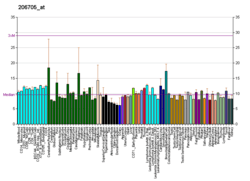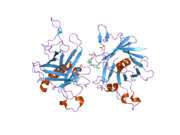TULP1
Tubby-related protein 1 is a protein that in humans is encoded by the TULP1 gene.[5][6][7]
TULP1 is a member of a family of tubby-like genes (TULPs) that encode proteins of unknown function. Members of this family have been identified in plants, vertebrates, and invertebrates. The TULP proteins share a conserved C-terminal region of approximately 200 amino acid residues. TULP1 is a candidate gene for retinitis pigmentosa-14 (RP). Mutation in TULP1 is a rare cause of recessive RP and TULP1 plays an essential role in the physiology of photoreceptors.[7]
References
- 1 2 3 GRCh38: Ensembl release 89: ENSG00000112041 - Ensembl, May 2017
- 1 2 3 GRCm38: Ensembl release 89: ENSMUSG00000037446 - Ensembl, May 2017
- ↑ "Human PubMed Reference:".
- ↑ "Mouse PubMed Reference:".
- ↑ North MA, Naggert JK, Yan Y, Noben-Trauth K, Nishina PM (May 1997). "Molecular characterization of TUB, TULP1, and TULP2, members of the novel tubby gene family and their possible relation to ocular diseases". Proc Natl Acad Sci U S A. 94 (7): 3128–33. doi:10.1073/pnas.94.7.3128. PMC 20333. PMID 9096357.
- ↑ Banerjee P, Lewis CA, Kleyn PW, Shugart YY, Ross BM, Penchaszadeh GK, Ott J, Jacobson SG, Gilliam TC, Knowles JA (Jun 1998). "Homozygosity and physical mapping of the autosomal recessive retinitis pigmentosa locus (RP14) on chromosome 6p21.3". Genomics. 48 (2): 171–7. doi:10.1006/geno.1997.5174. PMID 9521870.
- 1 2 "Entrez Gene: TULP1 tubby like protein 1".
Further reading
- Powles TJ, Rosset G, Leese CL, Bondy PK (1977). "Early morning hydroxyproline excretion in patients with breast cancer". Cancer. 38 (6): 2564–6. doi:10.1002/1097-0142(197612)38:6<2564::AID-CNCR2820380648>3.0.CO;2-W. PMID 1000483.
- Knowles JA, Shugart Y, Banerjee P, et al. (1995). "Identification of a locus, distinct from RDS-peripherin, for autosomal recessive retinitis pigmentosa on chromosome 6p". Hum. Mol. Genet. 3 (8): 1401–3. doi:10.1093/hmg/3.8.1401. PMID 7987322.
- Hagstrom SA, North MA, Nishina PL, et al. (1998). "Recessive mutations in the gene encoding the tubby-like protein TULP1 in patients with retinitis pigmentosa". Nat. Genet. 18 (2): 174–6. doi:10.1038/ng0298-174. PMID 9462750.
- Banerjee P, Kleyn PW, Knowles JA, et al. (1998). "TULP1 mutation in two extended Dominican kindreds with autosomal recessive retinitis pigmentosa". Nat. Genet. 18 (2): 177–9. doi:10.1038/ng0298-177. PMID 9462751.
- Gu S, Lennon A, Li Y, et al. (1998). "Tubby-like protein-1 mutations in autosomal recessive retinitis pigmentosa". Lancet. 351 (9109): 1103–4. doi:10.1016/S0140-6736(05)79384-3. PMID 9660588.
- Lewis CA, Batlle IR, Batlle KG, et al. (1999). "Tubby-like protein 1 homozygous splice-site mutation causes early-onset severe retinal degeneration". Invest. Ophthalmol. Vis. Sci. 40 (9): 2106–14. PMID 10440267.
- Hagstrom SA, Duyao M, North MA, Li T (1999). "Retinal degeneration in tulp1-/- mice: vesicular accumulation in the interphotoreceptor matrix". Invest. Ophthalmol. Vis. Sci. 40 (12): 2795–802. PMID 10549638.
- Ikeda S, Shiva N, Ikeda A, et al. (2000). "Retinal degeneration but not obesity is observed in null mutants of the tubby-like protein 1 gene". Hum. Mol. Genet. 9 (2): 155–63. doi:10.1093/hmg/9.2.155. PMID 10607826.
- Hagstrom SA, Adamian M, Scimeca M, et al. (2001). "A role for the Tubby-like protein 1 in rhodopsin transport". Invest. Ophthalmol. Vis. Sci. 42 (9): 1955–62. PMID 11481257.
- Strausberg RL, Feingold EA, Grouse LH, et al. (2003). "Generation and initial analysis of more than 15,000 full-length human and mouse cDNA sequences". Proc. Natl. Acad. Sci. U.S.A. 99 (26): 16899–903. doi:10.1073/pnas.242603899. PMC 139241. PMID 12477932.
- Brandenberger R, Wei H, Zhang S, et al. (2005). "Transcriptome characterization elucidates signaling networks that control human ES cell growth and differentiation". Nat. Biotechnol. 22 (6): 707–16. doi:10.1038/nbt971. PMID 15146197.
- Gerhard DS, Wagner L, Feingold EA, et al. (2004). "The status, quality, and expansion of the NIH full-length cDNA project: the Mammalian Gene Collection (MGC)". Genome Res. 14 (10B): 2121–7. doi:10.1101/gr.2596504. PMC 528928. PMID 15489334.
- Kondo H, Qin M, Mizota A, et al. (2005). "A homozygosity-based search for mutations in patients with autosomal recessive retinitis pigmentosa, using microsatellite markers". Invest. Ophthalmol. Vis. Sci. 45 (12): 4433–9. doi:10.1167/iovs.04-0544. PMID 15557452.
- Roni V, Carpio R, Wissinger B (2007). "Mapping of transcription start sites of human retina expressed genes". BMC Genomics. 8: 42. doi:10.1186/1471-2164-8-42. PMC 1802077. PMID 17286855.
- den Hollander AI, van Lith-Verhoeven JJ, Arends ML, et al. (2007). "Novel compound heterozygous TULP1 mutations in a family with severe early-onset retinitis pigmentosa". Arch. Ophthalmol. 125 (7): 932–5. doi:10.1001/archopht.125.7.932. PMID 17620573.
- Mataftsi A, Schorderet DF, Chachoua L, et al. (2007). "Novel TULP1 mutation causing leber congenital amaurosis or early onset retinal degeneration". Invest. Ophthalmol. Vis. Sci. 48 (11): 5160–7. doi:10.1167/iovs.06-1013. PMID 17962469.
- Guo Y, Prokudin I, Yu C, et al. (2014). "Advantage of Whole Exome Sequencing over Allele-specific and Targeted Segment Sequencing, in Detection of Novel TULP1 Mutation in Leber Congenital Amaurosis". Ophthalmic Genet.: 1–6. doi:10.3109/13816810.2014.886269. PMID 24547928.
This article is issued from
Wikipedia.
The text is licensed under Creative Commons - Attribution - Sharealike.
Additional terms may apply for the media files.






